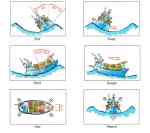Step 1 of 3•5 minutes read
Forces Acting on Cargo
Cargo is subjected to different forces depending on the mode of transport. At sea due to the motion of the water different requirements on how the cargo should be loaded and secured need to be managed carefully.

The sea can make a ship move in different ways and angles
Ships' Motions
At sea, the combination of wind and sea may create heavy ship movements, depending on the sea state and the sea-keeping characteristics of the individual vessel. Increased movements and accelerations acting on ships and cargo will obviously increase. Apart from accelerations, cargoes on open decks are also subjected to forces in the form of wind and green sea pressure.
Unlike road vehicles, a vessel at sea may move or rotate in any direction. The three rotational motions that a vessel may perform are called roll, pitch and yaw. The three linear motions that a vessel may perform are called sway, surge, and heave. Out of these, roll, pitch, and heave are the motions that contribute the most to high acceleration levels, resulting in great mass forces threatening to shift the cargo in different directions.
Accelerations and Mass Forces
According to the laws of physics, a unit is unwilling to change its speed or direction unless external forces influence it. For example, when you're driving a car and suddenly have to make a rapid brake, your body wants to continue its travel forward during the braking. In this case, you will be held in place by the seatbelt while the car is reducing speed. This is a typical situation where mass forces can be studied. Since wind and sea are constantly acting on the ship, in heavy and calm weather conditions, cargo is always exposed to accelerations due to changes in the ship's movements. When cargo units are subjected to accelerations, mass forces arise that strive to move the cargo. The greater the acceleration and the heavier the unit, the greater the resulting mass force.
Gravity
Gravity is one of the most important laws of nature when it comes to the creation of the world as we know it. Without gravity, nothing would have a fixed place, and our existence would surely be turned upside down. Due to gravity, all physical objects are constantly pulled against the centre of the earth by force equal to the unit's weight. This may be expressed as a downward acceleration of 1g.
However, at sea, due to the vessel's movement, cargo experience dynamic forces in the vertical direction acting in combination with the static force of gravity. When a vessel heaves, for example, dynamic forces will lift or pull down the cargo, reducing or increasing the pressure between the cargo and the vessel's deck.
Wind and Green Sea Forces
In addition to mass forces from accelerations and gravity, cargoes stowed on the weather deck are subjected to wind and green sea pressure. What impact wind and green sea have on the cargo depends on the exposed area of the cargo. Under the IMO Code of Safe Practice for Cargo Stowage and Securing, the amount of pressure that may affect the cargo by wind or green sea, respectively, may be estimated as 1 kN or 100 kg per square metre.
Motions a Cargo Unit May Perform
When cargo is insufficiently secured, it may start moving during the voyage. A cargo unit may either slide or tip, depending on its properties. A proper cargo securing arrangement must prevent the cargo from sliding and tipping in all directions when it is subjected to the worst forces expected during the intended voyage. While some cargoes are more likely to tip, other cargoes are more likely to slide. By this fact, different cargoes may need different types of securing arrangements, and it's therefore important to evaluate the risks separately for every single load.

Cargo can slide...

....and/or tip
Tipping
If a unit is likely to tip or not is determined by two important factors, the shape of the unit and the location of the center of gravity. As an example, it is more likely that tall and narrow units tip than low and wide ones. Thus, the relation between the height and the base area must always be considered when determining the risk of tipping. Furthermore, top-heavy cargo units or cargoes that have their weight concentrated on either side are more sensitive to tipping than cargo units with a center of gravity near or below their geometrical midpoint. Vehicles, machinery equipment, transformers, and heat exchangers are goods that may be sensitive to tipping.

Sliding cargo
Sliding
When a unit is subjected to lateral forces during sea transport, it may begin to slide along the deck or within a transport unit if inappropriately secured. A unit loaded on board a ship is subjected to lateral mass forces as soon as the ship begins to pitch or roll. These mass forces try to make the unit slide along the deck but are counteracted by friction forces, which try to hold the unit in place.
The magnitude of the friction force depends on the materials in the contact surface and the pressure between the cargo and the deck. Sawn wood on wood or rubber are examples of material combinations with high friction, while steel on steel is an example of hard and smooth contact surfaces with low friction. The lesser the friction magnitude, the more effort is needed to secure the cargo.